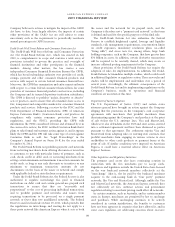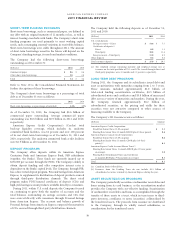American Express 2011 Annual Report Download - page 26
Download and view the complete annual report
Please find page 26 of the 2011 American Express annual report below. You can navigate through the pages in the report by either clicking on the pages listed below, or by using the keyword search tool below to find specific information within the annual report.AMERICAN EXPRESS COMPANY
2011 FINANCIAL REVIEW
Provisions for Losses
Provisions for losses of $1.1 billion in 2011 decreased $1.1 billion
or 50 percent, compared to 2010. Charge card provisions for
losses increased $175 million or 29 percent, primarily driven by
higher average receivable levels, higher write-offs and a release of
reserves in the prior year due to improved credit performance.
Cardmember loans provisions for losses decreased $1.3 billion or
83 percent, primarily reflecting lower write-offs and a lower
cardmember loan reserve requirement in 2011 compared to
2010. The lending write-off rate was 2.9 percent in 2011
compared to 5.6 percent in 2010. Other provisions for losses
increased 5 percent compared to the prior year.
Provisions for losses of $2.2 billion in 2010 decreased $3.1
billion or 58 percent, compared to 2009. Charge card provisions
for losses decreased $262 million or 31 percent, driven by lower
reserve requirements due to improved credit performance,
partially offset by higher receivables. Cardmember loans
provisions for losses decreased $2.7 billion or 64 percent,
primarily reflecting lower reserve requirements during the year,
due to improved credit performance, partially offset by an
increase related to the inclusion of the 2010 expense for
securitized loan write-offs as a result of new GAAP governing
consolidations and VIEs, which in 2009 and prior periods was
reported in net securitization income. Other provisions for losses
decreased $105 million or 55 percent primarily reflecting lower
merchant-related debit balances.
Expenses
Consolidated expenses for 2011 were $21.9 billion, up $2.5
billion or 13 percent from $19.4 billion in 2010. The increase in
2011 reflected higher cardmember rewards expenses, higher
salaries and employee benefits expenses, higher other expenses,
higher cardmember services expenses, greater professional
services expenses and higher occupancy and equipment expenses,
partially offset by lower marketing and promotion expenses.
Consolidated expenses for 2010 were $19.4 billion, up $3.2
billion or 20 percent from $16.2 billion in 2009. The increase in
2010 reflected higher marketing and promotion expenses,
increased cardmember rewards expense, higher salaries and
employee benefits, higher professional services expenses, higher
other expenses, and increased cardmember services expenses,
partially offset by lower occupancy and equipment expense and
lower communications expense. Consolidated expenses in 2011,
2010 and 2009 also included $153 million, $127 million and $190
million, respectively, of reengineering costs, of which $119
million, $96 million and $185 million, respectively, represent
restructuring charges.
Marketing and promotion expenses decreased $151 million or
5 percent to $3.0 billion in 2011 from $3.1 billion in 2010, due to
lower product media and brand spending. Marketing and
promotion expenses increased $1.1 billion or 57 percent to $3.1
billion in 2010 from $2.0 billion in 2009, as improved credit and
billings trends led to increased investments in growth businesses
in 2010.
Cardmember rewards expenses increased $1.2 billion or 24
percent to $6.2 billion in 2011 from $5.0 billion in 2010,
reflecting higher rewards-related spending volumes and
co-brand expense. Cardmembers’ increased engagement with the
Company’s Membership Rewards program drove an increase in
the ultimate redemption rate to 92 percent in 2011 from 91
percent in 2010. This resulted in higher rewards expenses
primarily driven by increased recent redemption patterns by U.S.
cardmembers. Cardmember rewards expenses increased $995
million or 25 percent to $5.0 billion in 2010 from $4.0 billion in
2009, reflecting higher rewards-related spending volumes and
co-brand expense, as well as a benefit in 2009 relating to the
adoption of a more restrictive redemption policy for accounts 30
days past due.
Cardmember services expenses increased $125 million or 21
percent to $716 million in 2011 from $591 million in 2010,
reflecting increased costs associated with new benefits made
available to U.S. cardmembers.
Salaries and employee benefits expenses increased $686 million
or 12 percent to $6.3 billion in 2011 from $5.6 billion in 2010,
reflecting higher employee levels, merit increases for existing
employees, increased benefit-related costs and higher incentive-
related compensation. Salaries and employee benefits expenses
increased $486 million or 10 percent to $5.6 billion in 2010 from
$5.1 billion in 2009, reflecting a 2 percent increase in total
employee count, merit increases for existing employees, higher
benefit-related costs, including the impact of reinstating certain
benefits that were temporarily suspended during the recession,
higher management incentive compensation expense and greater
volume-related sales incentives, partially offset by lower net
reengineering costs in 2010 versus 2009.
Professional services expenses in 2011 increased $145 million
or 5 percent compared to 2010, reflecting higher technology
development expenditures including various initiatives related to
digitizing the business, globalizing operating platforms and
enhancing analytical data and capabilities. Higher legal costs and
third-party merchant sales-force commissions also contributed
to the increase. Professional services expenses in 2010 increased
$398 million or 17 percent compared to 2009, reflecting higher
technology development expenditures, greater legal costs and
higher third-party merchant sales force commissions, partially
offset by lower credit and collection agency costs.
Other expenses in 2011 increased $460 million or 20 percent to
$2.8 billion compared to 2010, primarily reflecting $300 million
of MasterCard settlement payments received in 2010 that ceased
in the second quarter of 2011. In addition, higher other expenses
are driven by costs associated with Loyalty Partner, data
processing and software amortization expense, as well as lease
termination costs. Other expenses in 2010 increased $170 million
or 8 percent to $2.3 billion compared to 2009, reflecting the $180
million ($113 million after-tax) benefit in the third quarter of
2009 related to the accounting for a net investment in the
Company’s consolidated foreign subsidiaries, as well as higher
investments in business building initiatives and higher travel and
entertainment costs in 2010, partially offset by lower postage and
telephone-related costs and a charge of $63 million in 2009 for
certain property exits.
24
























